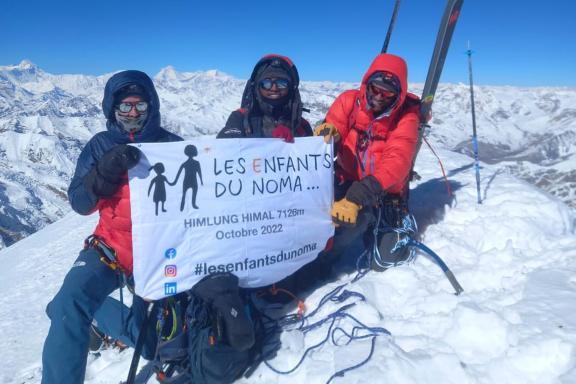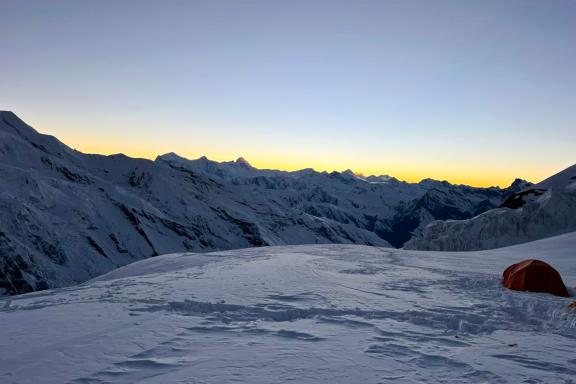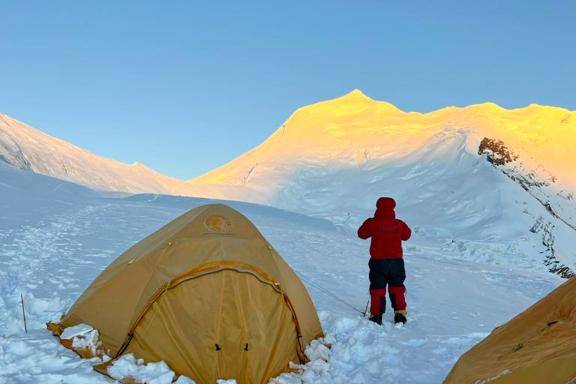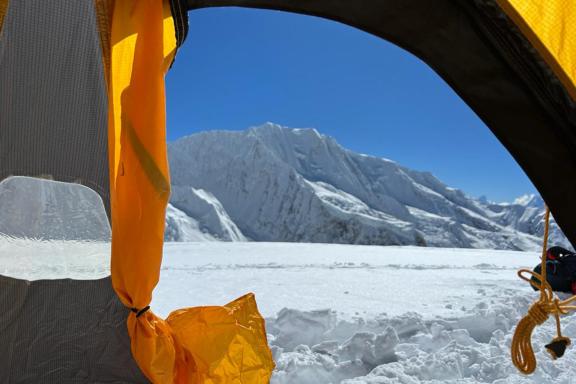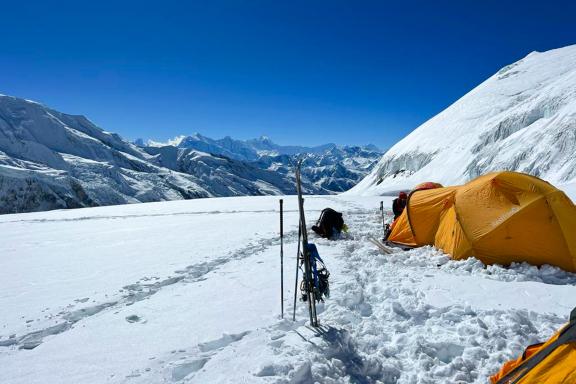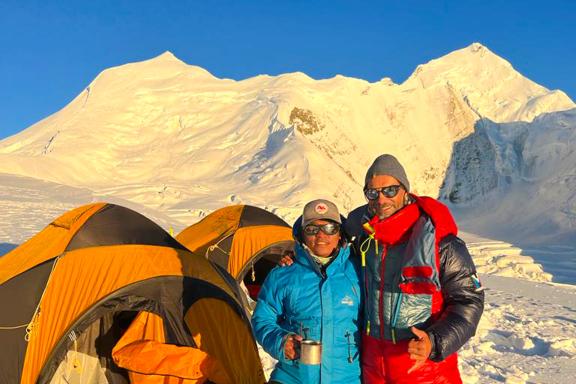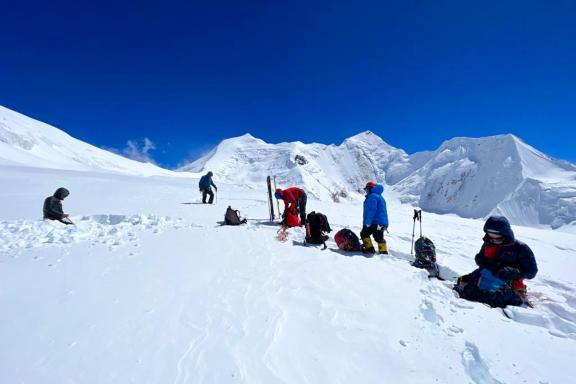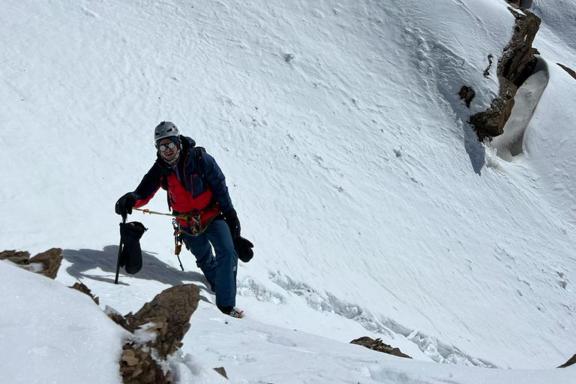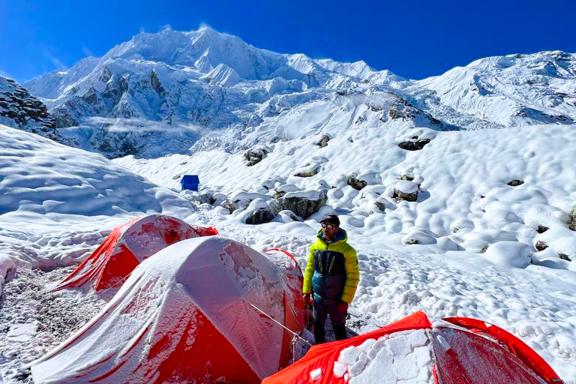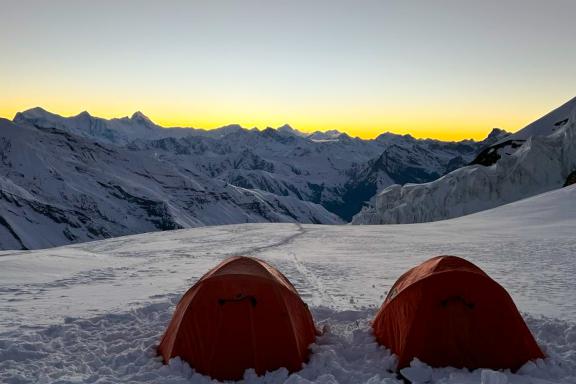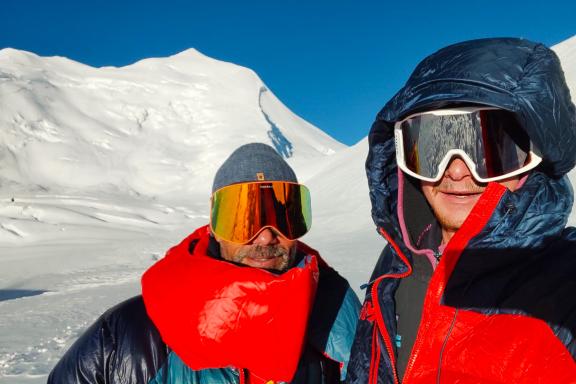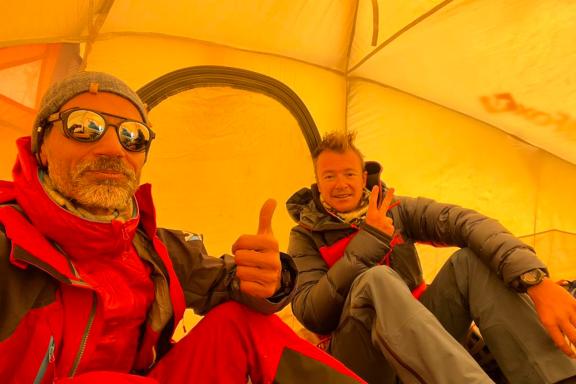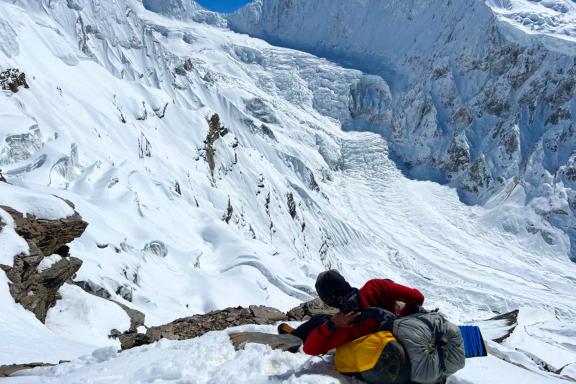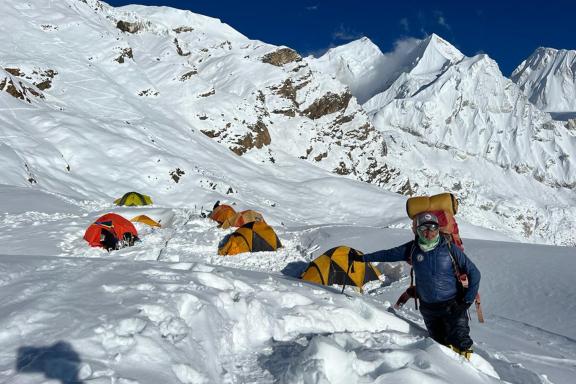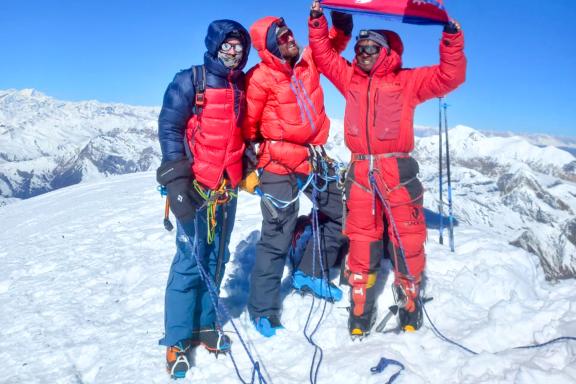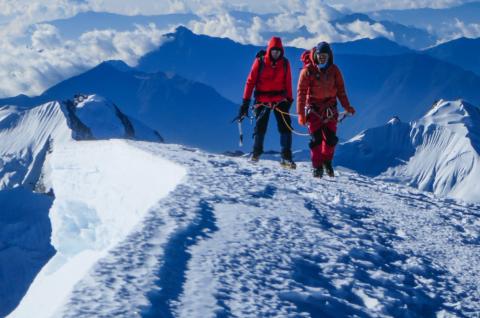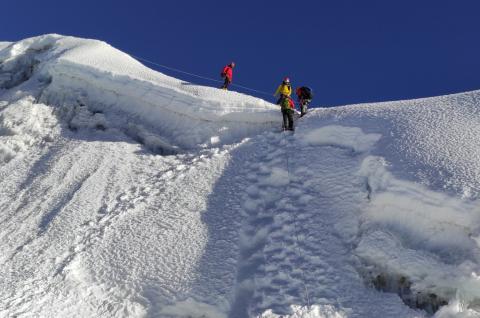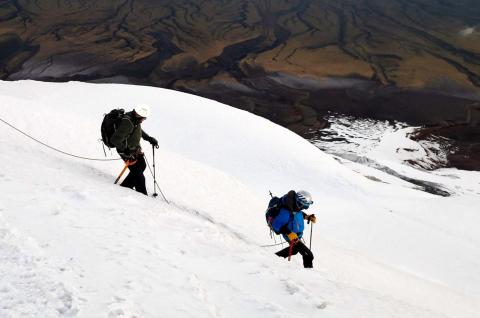Accessible 7000-meter ascent in Nepal
Highlights
- 1 sherpa to 1 participant ratio
- Itinerary designed to optimize summit success
- Advanced base camp for greater safety
- High-altitude porters for collective equipment
- Phu village and beautiful acclimatization trek
- Weather forecast and 24/24 medical hotline
- Preparation course, live coverage of the expedition
In a small group, we set out to climb Himlung Himal, a beautiful 7000 meter peak. Its ascent requires experience of high-altitude expeditions and technical mountaineering skills at a “Little Difficult” level in snow. Himlung Himal is an interesting summit to discover high altitude. We prefer the French base camp to the classic Kari Kobler camp, which is more exposed to avalanches. Himlung Himal remains a wild summit that can receive heavy snowfalls, making its ascent particularly physical. The approach walk offers a beautiful trek and our itinerary has been improved to better discover the region and acclimatize us gently. Our stay in the village of Phu allows us to immerse ourselves in the way of life of the high Himalayan valleys of Tibetan culture.
Overview
Himlung Himal is now Nepal's most popular 7000 meter peak. However, it is not the simplest technically; Putha Hiunchuli has been granted this privilege, but located further west and difficult to access, it remains more complex in terms of organization. Himlung Himal is therefore the ideal summit to discover high altitude and inevitably, it has become more frequented, especially in autumn. It is a summit that we know perfectly, and that we approach with an even more elaborate itinerary for a better approach to the region and a progressive acclimatization. The ascent takes place in a very high-mountain atmosphere and without significant objective risk. The first part of the route, from French Camp to Camp 3, is technically accessible. Then the altitude being felt, access to Camp 4 at Lung La is a little more physical, on large, not very steep slopes. On the last day, the route of the final ridge is more demanding and requires real ease in mountaineering, without being really difficult.
Here is the animated itinerary for the ascent of Himlung Himal at 7126 meters.
And check out Paulo Grobel's chronicle of our ascent of Himlung Himal.
Itinerary
DAYS 1 & 2: EUROPE – KATHMANDU
Day 1
Flight from Europe to Kathmandu. Arrival is usually on Day 2. Welcome by our local team and free time to enjoy the beautiful energy of the Boudhanath stupa. A haven of peace in the Buddhist heart of Kathmandu.
DAY 3: KATHMANDU
Day 3
DAYS 4 & 5: KATHMANDU – BESISAHAR – KOTO
Day 4
An early start for a two-day journey by bus and jeep. Not exactly a cup of tea, but impossible to do otherwise. Fortunately, the road gets better every year, and after lunch in Timang, it is possible to walk a little to stretch the legs...
DAY 6: KOTO – META
Day 6
End of vehicle transfer and start of the trek. Today, the terrain dictates and the stage is a little long, especially for the Nepalese team. It is not a good idea to camp in Dharamshala Meta is much better. So we got an early start and optimize our route with a few tea breaks and a lunch; the aim being not to arrive too late in Meta.
DAYS 7 & 8: META – NAAR – KHYANG
Day 7
This day is at once a cultural detour to visit the village of Naar, a short stopover and an acclimatization phase that allows us to sleep comfortably for the first night at 4000 meters. The next day, we return to the Khola and follow a beautiful trail to Khyang, Phu's winter village. Lodge in Naar and camping in Khyang. We use individual tents until we reach French Camp. And, as we are already at altitude, we devote a few briefings to how we can better prepare for our acclimatization and to discuss the hypoxic environment that is now our daily routine.
DAYS 9 & 10: KHYANG — PHU
Day 9
DAY 11: PHU — KARI KOBLER BASE CAMP
Day 11
And here we are, at the base camp in just half a day's walk. Kari Kobler Base Camp is a beautiful place, but unfortunately the water is a long way off for the kitchen staff. But we do not stay there long, as the very next day we will be crossing the Pangri Glacier to set up camp on the other side, at French Camp. This is really the start of our high-altitude adventure, as we will only return to the base camp at the end of the climb or if necessary.
DAY 12: KARI KOBLER BASE CAMP — FRENCH CAMP
Day 12
The French Camp is our advanced base camp, and the kitchen team moves in with us. This camp is close to the stream that flows out of the glacier, making it convenient for water. Secondly, French Camp seems safer in terms of objective dangers, particularly avalanches. Lastly, it allows us to avoid crossing the Black Glacier every time, a route that is both unpleasant and exposed to the passage of the moraine, whose boulders can erupt at any moment. Other expeditions usually stay at the Kari Kobler base camp... The day is not very long (around 2-3 hours) and we can even come back and carry our gear once we've settled in.
DAYS 13 TO 22: HIMLUNG HIMAL CLIMB
Day 13 to 22
Altitude camp locations:
- Advanced base camp (French Camp): 5000 meters
- Camp 1: 5400 meters
- Camp 2: 6050 meters
- Camp 3: 6200-6300 meters
For illustrative purposes only, here's what your ascent might look like. Your acclimatization strategy will depend mainly on the weather and the fitness of the participants, and will be specified on the mountain by your expedition leader.
First rotation to Camp 1 (5400 m)
Camp 1 is located 5 kilometers above the advanced base camp. Nothing difficult, the slope rises gently to a ridge that we follow, overlooking the small Himlung Lake. We climb up with our guides and set up camp. We spend the night here.
French Camp – camp 1:
Elevations: + 560 m / - 160 m (to camp 1)
Number of walking hours: 2 to 3 hours uphill (1 to 2 hours downhill)
Final altitude : approximately 5400 m
Second rotation to camp 2 (6050 m), possibly camp 3 (6200 / 6300 m)
On this second rotation, we spend a night at Camp 1 (5400m) and then continue our ascent to Camp 2 (6050 m). The climb from Camp 1 to Camp 2 takes around 7 hours (depending on snow conditions). We start with a 40° slope, then climb a steep couloir before overlooking the glacier. The climb is long and hard, and we're short of breath as we are now above 6000 meters.
A fixed rope is used to secure the passage over the crevasses and to enter the glacier via a more accessible section, always being wary of snow bridges. Once across the glacier, the slope rises again, with the summit of Himlung in sight. Arrival at Camp 2 is in an open area far enough away from any avalanche risk.
Camp 1 – camp 2:
Elevations: + 650 m (to camp 2)
Number of walking hours: 7 to 8 hours uphill (3 to 4 hours downhill)
Final altitude: approximately 6050 m
We spend the night at Camp 2 and, weather permitting, move on to Camp 3 (6200 / 6300 m) the following day to drop off equipment, then descend to French Camp.
Between camps 2 and 3, it's a good 2 hours of glacier walking with no technical difficulties, and camp 3 is located in an open area.
Camp 2 – camp 3 :
Elevations: + 250 m (to camp 3)
Number of walking hours: 2 to 3 hours uphill (1 to 2 hours downhill)
Final altitude: approximately 6300 m
Third and final rotation to Camp 3 (6200 / 6300 m) and Summit Push
During this third and final rotation, we generally climb directly to camp 2 (6050 m), then camp 3 (6200/6300 m) the following day. Finally, we leave in the night for the summit.
From camp 3, we start with a glacier walk, sometimes slightly downhill, which leads to an easy but slightly exposed traverse below the col. A short climb of around 100 meters at between 50 and 60°, using fixed ropes, takes us to the Himlung pass at 6,400 meters.
From here, the slope is gentle at first, then rises steadily without exceeding 40-45° to the summit of Himlung Himal at 7126m (with a small rise at the end of the ascent). From the col to the summit, the glacier walk is demanding due to the incline, the hypoxia and, very often, the wind sweeping across the face. Slowness and regularity are the key. A few scattered crevasses depending on the season and conditions. Sometimes, in autumn, the snow is so deep that we have to make tracks, making the ascent even more difficult.
From the summit, we enjoy a breathtaking view of the Manaslu... The descent is not too difficult, following the same itinerary, but keeping a watchful eye on your footing, which has to be sure-footed on such slopes. From the pass, the steep slope is descended rappelling on fixed ropes.
Return to Camp 2 for the night, or even to Camp 1 or French Camp on the same day for the fittest!
Camp 3 – Sommet :
Elevations : + 1000 m / - 150 m (to the summit)
Number of walking hours: 8 à 10 hours uphill (4 à 5 hours downhill)
Final altitude: approximately 7126 m
Accommodation and meals during ascent,
DAY 23: KARI KOBLER BASE CAMP
Day 23
A day of tidying up and cleaning at base camp, and packing for the return trip. It is the end of the expedition, but not the end of the journey yet.
DAYS 24 TO 26: KARI KOBLER BASE CAMP – KOTO
Day 24
Three days of trekking to reach the Marsyangdi valley and the Koto lodges, on the Annapurna tour. The route is now well known and the valley is as beautiful as ever. The owner of Mountain View Lodge is waiting for us, as is our first hot shower...
DAY 27: KOTO — KATHMANDU
Day 27
An early start by jeep, then dal bhat to Besisahar and a bus to Kathmandu. Another efficient day. Fortunately, the road is getting better and better... But the arrival in Kathmandu is still just as traumatic.
DAY 28: KATHMANDU
Day 28
Final day and free time in Kathmandu before departure the following day.
DAYS 29 & 30: KATHMANDU — INTERNATIONAL FLIGHT — EUROPE
Day 29
END OF EXPEDITION
For reasons that cannot be foreseen at this stage, such as unpredictable weather, the physical fitness or lack of fitness of participants or other circumstancess (customs formalities, road conditions, traffic, landslides, force majeure, etc.), your expedition leader may have to adapt the program, if necessary, to ensure the smooth running of your trip. He remains the sole judge and the one who guarantees your safety. Activity times are given as an indication and may vary from one participant to another.
The itinerary for all our expedition programs, or the ascent program for our high-mountain expeditions, are given here as a guide only. They are flexible enough to adapt to weather conditions with a few contingency days. In any case, you should follow the recommendations of your guide, who may suggest that you cancel your expedition due to weather, safety or physical conditions.
It is important to remember that this is a truly unsupported expedition, and that anything can happen. Expeditions Unlimited, your expedition leader, your guide or our local teams can in no way be held responsible.
Any costs incurred as a result of a change in the expedition schedule (extra nights' accommodation, extra flights) will be borne by the participants and not by the organizers. "Contingency days" refer to the expedition in the strict sense of the term (base camp/base camp in the mountains, departure point/exit point on a traverse, etc.).
Any early return of the expedition or of certain members only (early success, abandonment, etc.), generating costs for accommodation, meals, changes to air tickets or other activities not provided for in this program, will be charged in full to the participants.
Trip notes
Guiding
YOUR PRIVATE GUIDE
Key to your success on all our expeditions, we systematically use a ratio of one high-altitude sherpa per participant. He accompanies you during the key moments of the ascent and during the summit push. He is particularly experienced at high altitude. We select him for you. He generally speaks English. He may not be with you all the time during rotations between camps, as his role is also to manage the carrying operations to set up the camps.
A summit bonus is also arranged for your high-altitude sherpa, to be paid in cash on site after the ascent. This bonus is due from the moment you leave the last summit camp on your summit push attempt.
Our team of "altitude sherpas" can be made up of several Nepalese ethnic groups, Sherpa of course, but also Tamang, Gurung, Rai, Bothe, etc.
EXPEDITION LEADER
The expedition leader plays an important role in setting up the logistics of the upper camps and implementing the strategy required for success: rotation in the high-altitude camps, acclimatization of each participant, study of weather reports to decide on the optimum moment to launch the summit push.
The expedition leader represents Expeditions Unlimited to the group, our partners and local authorities. Mainly based at base camp, he may accompany you to the high-altitude camps to oversee the logistics of the expedition. He takes any necessary decisions. His authority is absolute and undeniable. You must respect his decisions, as well as those taken collectively.
From one to five participants, you have a local English-speaking Nepalese expedition leader who has coordinated numerous expeditions to high-altitude peaks. He can be shared with other expeditions. He can also be one of the private guides described above, usually the most experienced. In this case, he combines the two functions of expedition leader and guide (see above).
For groups of six or more participants, an experienced French expedition leader is assigned exclusively to your expedition.
LOCAL TEAM
For a project involving the ascent of a major Himalayan peak, our team is particularly well-staffed to deal as effectively as possible with the two key issues of an expedition: technical supervision and the carrying of equipment (food, collective and personal equipment). This is an important issue, as it directly affects the success of both parties. As a result of more than 10 years of joint reflection and work, our operation is fully optimized and the tasks entrusted to each person determine their own status.
A kitchen staff will be present at base camp.
There is a team of porters who help us set up base camp with all the equipment and cooking facilities. Beyond that, the team of high-altitude sherpas takes over. In particular, they help us to set up the high-altitude camps and with the carrying from base camp.
Each participant is responsible for carrying his or her own personal belongings and high-altitude food. Our rucksack will weigh between 10 and 12 kg. Collective equipment is carried by the Nepalese team.
And throughout the program, we will rely on other local skills as needed. Finally, we will have access to personalized weather forecast services and a specialized high-altitude doctor from Ifremmont (see above).
For unpredictable reasons at this stage, like adverse weather conditions, insufficient physical condition of participants, insufficient competencies of participants related to the intended activities, your guide may decide to adjust the intended program and/or activities. At all times, his decision will be final on all matters likely to affect the safety and well-being of the trip.
Difficulty level
Level rated: difficult
This program is aimed at participants in good physical shape, with a significant sport practice, endurance in particular, holding a strong mental to face difficulties that are unforeseen by nature.
This is a difficult program, given the high altitude at which you will be climbing. You need to have significant mountaineering experience, and active hiking, trekking or mountaineering experience to be as self-sufficient as possible. You will need to know how to progress in a roped party, either on your own or roped up with your guide, and how to handle ropes.
To optimize your chances of success, you need to be well-prepared, both physically and mentally, given the high altitude and hostile environment (remoteness, cold, bad weather, discomfort). Team spirit is equally important. Each participant is responsible for applying safety rules, looking after his or her own equipment and maintenance, setting up camp and preparing meals. As always in this type of project, the key to success is teamwork and team spirit.
Therefore, participation in the preparation course, the date of which will be specified later, is mandatory. In addition, mountaineering preparation courses as part of our Adventure School can be a serious asset, both to build confidence and to gain autonomy.
To register for this expedition, you will be asked to provide an expedition (mountain climb list)/trek/athlete CV. A hypoxic stress medical test is also mandatory, as is a medical certificate for completing an ascent in the Himalayas.
You benefit, free of charge and for the duration of your expedition, from membership in the 24/7 high altitude medical service set up with our partner Ifremmont, of which we are partners. See below.
If you have any health problems that you feel could compromise the success of your expedition, please let us know so that we can assess together whether they are compatible with this expedition. And we strongly advise you to have a check-up with your dentist before departure, given the length of the expedition and the significant variations in altitude and pressure.
Last but not least, we can provide you with a sports coach and/or a mental coach for the months leading up to your expedition, to help you prepare in the best possible conditions. We have developed remote protocols in this field, just as we have built a hypoxia preparation protocol which we describe later in this document in the chapter devoted to Ifremmont.
In the longer term, we offer refresher and advanced mountaineering courses as part of our Adventure School, as well as expeditions to peaks at 5000, 6000 and 7000 meters, offering you the ideal progression towards your dream goal at very high altitude.
Technical difficulty
Mountaineering level: PD like... A little difficult (Peu Difficile in French)
This expedition requires experience of high-altitude expeditions and technical mountaineering skills at PD level (comfortable on 30/35° snow slopes). In this program, the use of mountaineering equipment (crampons, harness, ice ax, ropes, etc.) is necessary and the route tackled may involve small difficulties, whether it is a little more inclined during glacier mountaineering, height of the walls, the length and the continuity of the efforts. It is therefore aimed at rough beginners who already have a little experience in mountaineering, who have already completed a few races of this level or slightly below. The mountaineering courses at our Adventure School from three days are for you. And this technical rating applies of course to normal weather conditions: the difficulty can increase in the event of bad conditions, fresh snow on rocks, insufficient or lack of quality of ice, etc. Likewise, the situation changes radically, for the same technical level, with the altitude, the weight of the bag, the lack of equipment on the route, the fatigue associated with the approach if it is long, the environment, if particularly hostile, etc.
Meeting point
We meet up in Kathmandu and are welcomed at the airport by our local teams.
Given the diverse origins of the participants on this trip, international outward and return flights are not included in this package. In most cases, we book flights on your behalf to ensure that the whole group arrives at the destination at the same time. We do not charge any fees for these air bookings. Please do not hesitate to contact us. If you book your own tickets, we will advise you on the ideal flight schedule to enable all participants to arrive within a reduced time frame. At the very least, you need tickets that can be modified.
Accommodations
KATHMANDU AND TREKKING
In a single room in a 3/4-star (***) hotel accommodation in Kathmandu.
During the trek, we will be staying either in individual tents or in lodges. Lodges in Nepal are of very random comfort. Lodges can resemble a refuge or sometimes our local B&B. Most are family homes with double, triple or dormitory rooms. Toilets and showers are always separate. It is important to check that the water is not heated with wood, as this contributes to deforestation. Most of the time, water is heated with solar energy.
BASE CAMP
At base camp, we stay in individual tents.
The base camp is our home for several weeks, and must be as comfortable as possible to allow us to recuperate properly on our return from the altitude camps. It should also enable us to cope with periods of bad weather in the best possible conditions. Each participant has his or her own individual tent with a comfortable mattress. A mess tent is the main living area. Tables and chairs are permanently installed. We also have a shower tent and a toilet tent.
HIGH-ALTITUDE CAMPS
During the ascent, at the altitude camps, we have an altitude tent for 2 people, or even 3 people at the last camps.
Meals
KATHMANDU AND TREKKING
On arrival in Kathmandu, a welcome dinner is offered on the first evening. Similarly, on your return from the expedition, a farewell meal is provided.
In the towns, there are many small (and large) restaurants where you can sample typical local cuisine. With the exception of Kathmandu, breakfasts and evening meals are prepared by the lodge's kitchen staff or cooks and served in the lodge's dining room or mess tent. Depending on the profile of the stages (length of the day's walk and/or presence of water), midday snacks will be served hot or cold in the form of picnics.
BASE CAMP
All meals are prepared by the kitchen staff using local ingredients, including rice, pasta, lentils, potatoes, vegetables, eggs, a little meat, etc. They are served in a private tent. Hot non-alcoholic beverages such as tea and coffee are provided free of charge. We recommend that you stay hydrated at all times.
HIGH-ALTITUDE CAMPS
At altitude, you often have to force yourself to eat. The use of freeze-dried food is almost unavoidable. But such dishes, appetizing in the valley, quickly become a source of disgust in high altitude camps. During the preparation course, we bring a sample of lyophilized dishes for you to taste, to indicate your preferences, which we do our utmost to respect (depending on the stocks available at the time of final purchase). You can also bring along a few of your favorite dishes (if you have any)or small snacks that give you pleasure (cold meats, cheese, etc.), or energy bars as the ones on offer locally are sufficient but basic, and so on. Be careful with the weight – we are talking about a kilo in all! For your comfort and the pleasure of tasting, we have included a few "delicacies" from France (savoury and sweet).
Each tent has a stove for melting snow (MSR Reactor type) and making water for freeze-dried food and hot drinks. The necessary gas cartridges are supplied.
HYDRATION
Take along tablets (such as Hydroclonazone, Micropur or others) to disinfect the water you put in your water bottle, depending on the source and on the advice of your guide. It is sometimes possible to buy purified water and fill your bottle without having to buy environmentally unfriendly bottled water.
Besides, glacier meltwater contains no mineral salts, which is partly compensated for by the soups and other meals you will be eating. But if you only drink tea or coffee made from glacier meltwater, or just water in your water bottles, over a long expedition, you will hydrate less well, risk gastric problems and, ultimately, deficiencies that will tire the body. To counter this problem, it is a good idea to pack mineral tablets in your luggage at some point, to supplement your water bottle. Two or three tubes of ten tablets are all you need.
Transfers / Transport
Transfers to and from the airport are by minibus or private car.
DISCLAIMER ON FLIGHTS WITHIN NEPAL: We offer participants in our journeys to Nepal the option of local air transfers. However, it is our duty to inform you that this transfer is only possible with a local Nepalese airline. And it is a fact that all local Nepalese airlines are blacklisted by the European Union as “insufficiently safe”. Other civil airlines around the world have not issued this review. We fly exclusively with the following three airlines: Tara Air, Buddha Air, Yeti Airlines, as they have recently been audited by an independent body and found to have acceptable safety conditions.
We ask you to sign the “information attestation form” which you will find at the end of this form with the registration form.
Group size
The group is composed of 2 to 8 participants maximum. The number of participants is deliberately limited to allow for greater immersion, to avoid embarrassing our hosts, and to develop freedom and flexibility. However, the maximum number may be exceeded if the last person to register wishes to travel with one or more other people. The services will not be modified, and the conditions of the trip will remain the same.
Equipment
COLLECTIVE EQUIPMENT
All logistical equipment is provided, including individual tents at base camp with mattresses, mess tent, shower tent and toilet tent, as well as all collective and individual cooking equipment. At altitude, tents, stoves with gas cartridges, ropes and anchors.
INDIVIDUAL EQUIPMENT
Personal equipment is not provided. A full list is given later in this document. It will be refined with us during the preparation course and up to the moment of departure, depending on your questions.
High-altitude sleeping bags, full-body down suits and/or good-quality down jackets are expensive items that you may not use frequently. We can rent you this specific equipment for the duration of the expedition. You must then return the equipment cleaned and in the condition in which it was given to you (deposit required). The rental price will be communicated to you on request. The cost of transport remains your responsibility, unless you pick it up at the agency in Lyon.
SECURITY AND COMMUNICATION
We have a minimum of one Iridium satellite phone for the group, which is used for logistical, weather and safety purposes only. Under certain conditions, participants may make use of it. For private use, please contact us.
The camps will be permanently linked by radio. Expedition leader, participants and high-altitude sherpas will also be able to use them.
The expedition will have a hyperbaric chamber at base camp, and a full pharmacy, though lighter, at the upper camps.
The group will be equipped with a Garmin Inreach beacon, enabling you to communicate freely and without restriction with your friends and family, wherever you may be on the mountain, as well as sending tracking and safety information. It is on this beacon that you will receive weather forecasts and that we will communicate together regularly.
At the same time, we will provide live coverage of the expedition for the general public, including a logbook and photographs, enabling you to share your adventure with your community. To this end, and if the base camp is not equipped with wifi or 4G, you can also use an IridiumGo system to send your photos. These systems are simple to use, but require a few tests before departure, which we will carry out together.
In addition, at the time of writing, all participants are free to bring any systems they have. We just need to be able to declare them to our contacts, so please let us know in advance.
Please note: in order to preserve the serenity of this expedition and the privacy of the participants, we ask you not to communicate with the general public during the expedition. You are, however, free to send information about yourself to your private sphere. By registering for this program, you accept this essential clause to protect the privacy of other participants in a project of this scale, where important issues of image, physical risk and financial considerations (sponsors, etc.) are at stake.
Our commitments to sustainable development
Our commitment to a better planet has been a reality since the beginning of our story but we always need to do more and better. Please find out more about our charter and our commitments in terms of sustainable development. We have drafted our charter and take action through six themes on which we act as concretely as possible, most often with you: social equity and cultural respect, preservation of water, waste management in expedition, protection of biodiversity, raise public awareness on these subjects and finally, the optimization and recovery of CO2 emissions.
Regarding carbon emissions, most of which are due to air travel, we calculated and communicated in 2018 on the carbon footprint of each of our programs, expressed in tonnes of CO2.
These calculations made us aware of the importance of the total carbon emissions generated by our activity. Also, we have committed in 2022 to a carbon reduction that we believe is unprecedented in the tourism industry, aiming to reduce the total emissions of our activity by 5% per year, taking 2019 as the reference year (3,430 tonnes of CO2). This commitment is in line with the trajectory of the Paris climate agreements of 2015, the current benchmark. Thus, in 2030, we commit ourselves not to exceed 2,160 tonnes of C02. Thus, our maximum “carbon” budget for 2024 is 2,950 tonnes and for 2025, this budget will be reduced to 2,800 tonnes. And so on until 2030. To find out more about all of our calculations and our commitments in terms of reducing our carbon emissions.
In addition, since 2019, we have been encouraging you when you book for your journey to contribute with a donation to an independent NGO, among the two we have selected that share the commitments made in our charter. We matched the amount of this donation to this program's carbon footprint. Thus, the journey you are considering generates 3,47 tons of CO2, which corresponds to a 100% donation of €104 for an estimated value today of €30 per tonne of CO2. This donation remains of course optional and you can decide to give between nothing and 100% of this amount. Since 2019, including covid years of 2020 and 2021, we have been able to collect thanks to you nearly €7,000 for these associations.
Please do not hesitate to come back to us with any questions you might have regarding this carbon footprint mechanism, our other sustainable développement commitments or even to share with us your experience through a chat or a mail at contact@secret-planet.com.
Expert
Himlung Himal is a technically accessible 7000 meter peak in Nepal, with a fine acclimatization trek, the most accessible of those we offer in this part of the world. That said, late monsoon snowfalls can make it a particularly physical climb. We prefer French Base Camp to Kari Kobler Camp, which is more popular and yet, from our point of view, more exposed to avalanches. Our local team, trained by French mountain guide Paulo Grobel, knows it inside out.
Expedition leader
We rely on the most experienced high altitude expedition leaders. They are part of our close community and co-opt each other. They know each other well and respect each other.
For this expedition, the expedition leader has not yet been formally appointed, but should be shortly.
In addition to their exceptional expeditions experience, our expedition leaders have the know-how to optimize the expedition's chances of success, both in terms of group management and in terms of the pace at which the group builds up its strength and progresses in altitude, key elements in this type of expedition.
Reviews
François F.
Hello François, thank you for your review of your expedition to climb Himlung Himal (7126 m) in Nepal with Paulo Grobel as expedition leader.
Departures and pricing
Please find below all dates and prices for this expedition. Prices are quoted "from" and may be adjusted notably according to the number of participants (see trip notes for details). Please note that dates and prices for years beyond 2024, when given, are for guidance only and are subject to change and readjustment to take account of current economic realities.
No date works for me!
I initiate a new datePrice includes
- Welcome and closing dinner in Kathmandu
- 3/4 star (***) hotel accommodation in Kathmandu with breakfast, single room, for two nights
- Airport/hotel transfers in Kathmandu
- Minibus and 4x4 transfers Kathmandu/Koto/Meta
- Full-board accommodation in lodge or tent during the trek
- Base camp food supply
- Carrying of personal belongings during the trek
- Base camp equipment: fully-equipped kitchen tent, heated mess tent for meals, tables and chairs, toilet tent, shower tent
- A cook and his assistant at base camp
- Base camp kitchen and mess tents for participants and Nepalese team
- Altitude tents, altitude food, stoves and fuel
- Insurance for altitude guides (evacuation, hospitalization, medical expenses, life insurance), cook and kitchen helpers
- Experienced French expedition leader for 6 or more participants. For less than 6 participants, the expedition leader is Nepalese, and his mission can be carried out by one of the more experienced Nepalese altitude guides (see below)
- An experienced Sirdar to manage local teams
- 1 Nepalese altitude guide for 1 participant: he carries food and equipment to the high camps and assists you on the final ascent
- Collective equipment needed for the ascent (fixed ropes, anchors)
- 1 walkie-talkie for each rope party (1 altitude guide and 1 participant)
- Equipment allowance, fees, tent and food for the cook and his helpers
- 1 satellite telephone at base camp (for emergency use only)
- Solar panels at base camp for charging small electronic equipment (such as cell phones and cameras). Not sufficient to charge computers
- Taxes and climbing permits, rope fixing fee and all government environmental taxes and garbage deposit
- Personalized weather forecast services
- Medical follow-up by Ifremmont during the expedition (see above)
- Preparation course (practical, medical)
- Live expedition coverage for your community (supply of InReach beacon, IridiumGo and subscriptions, LivExplorer service configuration)
Price does not include
- International flights
- Consular fees (visa)
- Any customs taxes upon arrival in Nepal
- Import taxes, if any, for satellite phones, professional communications equipment and commercial filming
- Any additional hotel nights in Kathmandu (over 2 nights)
- Any helicopter transfer
- Meals in Kathmandu other than breakfasts, welcome meal and farewell meal
- Expenses related to the early return of the expedition or of certain members only (early success, abandonment, etc.), generating costs for accommodation, meals, changes to air tickets or other activities not provided for in this program
- Expenses related to a shift in the expedition schedule (extra nights' accommodation and meals, additional airfares)
- US$800 summit bonus for your altitude guide, to be paid on site after the ascent (whether the summit is reached or not)
- Tips for local staff: 250 US$/participant
- Any personal communications by satellite phone (to be paid on site)
- Pre-acclimatization protocol developed with Ifremmont and Sport Altitude (personalization, advice, follow-up, equipment) as described above
- Personal equipment including individual high-altitude gear
- Rental of personal high-altitude equipment, subject to availability
- Additional oxygen cylinders (approx. US$500, subject to availability)
- Pre-acclimatization protocol developed with Ifremmont and physical and/or mental preparation with a specialist Sport Altitude coach as described above
- Drinks and all personal expenses (personal visits, cabs, souvenirs, dry cleaning, etc.)
- Travel and expedition insurance (assistance, evacuation and repatriation)
Your custom expedition
We put our expertise, our knowledge of the terrain, our creativity, our experience, the quality of our guides and the reliability of our partners at your service to build your custom expedition. We can also personalize an expedition to your wishes as soon as you form a "closed" group, whatever the number of participants.
This means that, unless you authorize us to do otherwise, no outside participants join you, and we can personalize your expedition by adapting it to your own pace, with the program extensions you desire, a higher level of comfort, certain activities, other encounters, etc.
Every expedition of this type is subject to a specific quotation. To get in touch with us now, please fill in the short questionnaire below. One of our experts will get back to you to refine your request and make you a proposal.

